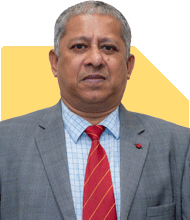46-Year-Old Aims to Build a 2 Crore Corpus in 5 Years - How Much to Invest?
Ramalingam Kalirajan |9255 Answers |Ask -Follow
Mutual Funds, Financial Planning Expert - Answered on Oct 16, 2024
He has an MBA in finance from the University of Madras and is a certified financial planner.
He is the director and chief financial planner at Holistic Investment, a Chennai-based firm that offers financial planning and wealth management advice.... more

Dear Sir , i am 46 years old .. Apart from properties i don't have any market investment. My aim is to have build a corpus of 2 crores in 5 years with SIP . Kindly advice on how much monthly i should be investing and what kind of funds or areas should i be investing ?
1. Setting Realistic Expectations
With a 5-year investment horizon, aiming for Rs. 2 crores means your investments need to grow at a significant rate. Considering the time frame, equity mutual funds are your best option to achieve high returns, but you must also balance the risk.
Equity mutual funds have historically given annual returns between 10-15% over the long term.
In a 5-year period, you need to invest in funds that have the potential for higher returns, like mid-cap or small-cap funds. However, be prepared for volatility.
2. Required Monthly SIP Investment
To achieve Rs. 2 crores in 5 years, your SIP contributions will need to be substantial. Without going into complex formulas, we can estimate the monthly investment needed based on a 12-15% return assumption.
At 12% return: You would need to invest approximately Rs. 2.7 lakh per month.
At 15% return: You would need to invest approximately Rs. 2.5 lakh per month.
These are broad estimates and can vary based on market conditions. If you start with a lower SIP amount, consider increasing it over time with step-up SIPs, where you gradually increase your SIP amount each year.
3. Investment Strategy: Diversified and Balanced
Since your time frame is short, it’s important to balance risk and returns. Here’s how you can allocate your investments:
3.1 Equity Mutual Funds
Equity mutual funds are the most suitable for achieving your goal. Within this category, you can focus on:
Large-Cap Funds: These funds invest in well-established companies, providing relatively stable growth with lower risk than small-cap funds. These funds should form about 30-40% of your portfolio to provide stability.
Mid-Cap and Small-Cap Funds: These funds invest in medium and smaller companies. While they are riskier, they have the potential to deliver higher returns. Allocate around 30-40% to these funds to boost your returns. Be aware that small-cap funds can be volatile, especially in the short term, but they can significantly contribute to your goal over 5 years.
3.2 Aggressive Hybrid Funds
These funds invest in a mix of equity (around 65-80%) and debt (20-35%). They provide a balance between risk and return. This is ideal for someone nearing retirement but still looking for aggressive growth. You can allocate around 20-30% of your investment to such funds.
3.3 Sectoral and Thematic Funds
If you are willing to take additional risk, you could consider investing in sectoral or thematic funds. These funds focus on specific sectors like technology, healthcare, or banking. These funds are risky but can provide high returns if the sector performs well. Limit this to 10-15% of your portfolio, as these funds can be volatile.
4. Avoid Index Funds
You may come across suggestions for index funds, but they are not suitable for your goal. Index funds aim to replicate the performance of the stock market index, like Nifty or Sensex. While they are passive and have lower management costs, their returns are often moderate compared to actively managed funds. Your goal of Rs. 2 crores in 5 years requires higher returns, which can be achieved through active management.
5. Avoid Direct Funds
While direct funds are cheaper since they don’t involve distributor commissions, they lack the guidance and expertise of an experienced Certified Financial Planner (CFP). You will benefit more from regular funds, where an expert can help you navigate market fluctuations, adjust your portfolio, and rebalance based on your goals.
6. Review and Adjust Portfolio Regularly
Since the market can be volatile, especially in the short term, you must review your portfolio every 6 months. A Certified Financial Planner can help you with this by adjusting your investments based on performance. Regular reviews also ensure that you’re on track to reach your Rs. 2 crore goal.
Rebalance your portfolio if certain funds are underperforming.
Increase your SIP amount if necessary.
Switch between funds as market conditions change, focusing on areas of higher growth potential.
7. Surrender LIC Policies and Focus on Mutual Funds
If you hold traditional insurance products like LIC or ULIP plans, their returns typically range around 6-8%, which won’t help you achieve your aggressive goal of Rs. 2 crores in 5 years. It’s advisable to surrender such policies and redirect the funds towards high-growth mutual funds. Pure insurance plans such as term insurance are a better option for covering risk.
8. Tax Planning
As you invest in equity mutual funds, be aware of the new capital gains tax rules:
LTCG (Long-term capital gains) above Rs. 1.25 lakh are taxed at 12.5%.
STCG (Short-term capital gains) are taxed at 20%.
For debt mutual funds, both short-term and long-term capital gains are taxed according to your income tax slab. Factor this into your planning when deciding when to redeem your investments. Tax-efficient strategies, such as holding your investments for over one year, can help you minimise tax.
9. Emergency Fund
Ensure you maintain an emergency fund before committing to aggressive SIPs. Since your time horizon is only 5 years, it’s crucial to have enough liquidity to handle unexpected expenses without disturbing your investments. Typically, an emergency fund should cover 6-12 months of living expenses. You could park this in low-risk debt funds or fixed deposits for easy access.
10. Insurance Cover
Before focusing on your investment goals, it is important to have adequate life and health insurance cover. A term insurance policy with adequate cover can safeguard your family's financial future. Health insurance is equally important to cover any medical emergencies. If you have existing LIC policies, evaluate if they offer sufficient cover. Otherwise, opt for a term plan.
11. Stay Disciplined and Patient
Achieving Rs. 2 crores in 5 years is possible, but it requires commitment and discipline. Avoid panic selling during market corrections and keep your long-term goals in mind. SIPs inherently provide rupee cost averaging, so market volatility works to your advantage over time.
Finally, while an aggressive approach is needed, avoid putting all your eggs in one basket. Diversification is key to mitigating risk and ensuring your money grows steadily.
Final Insights
Building a Rs. 2 crore corpus in 5 years through SIPs is a challenging yet achievable goal with a disciplined and strategic approach. You will need to make significant monthly investments in a diversified portfolio of equity mutual funds, hybrid funds, and sectoral funds. Regular portfolio reviews, combined with disciplined investing, will help you stay on track.
Work closely with a Certified Financial Planner to review your progress and make the necessary adjustments to your portfolio as market conditions change.
Best Regards,
K. Ramalingam, MBA, CFP,
Chief Financial Planner,
www.holisticinvestment.in
https://www.youtube.com/@HolisticInvestment
You may like to see similar questions and answers below
Nikunj Saraf | Answer |Ask -Follow
Mutual Funds Expert - Answered on May 22, 2023
Ramalingam Kalirajan |9255 Answers |Ask -Follow
Mutual Funds, Financial Planning Expert - Answered on Apr 23, 2024
Ramalingam Kalirajan |9255 Answers |Ask -Follow
Mutual Funds, Financial Planning Expert - Answered on May 22, 2024
Ramalingam Kalirajan |9255 Answers |Ask -Follow
Mutual Funds, Financial Planning Expert - Answered on Jul 29, 2024
Ramalingam Kalirajan |9255 Answers |Ask -Follow
Mutual Funds, Financial Planning Expert - Answered on Sep 19, 2024
Nayagam P P |7368 Answers |Ask -Follow
Career Counsellor - Answered on Jun 29, 2025
Nayagam P P |7368 Answers |Ask -Follow
Career Counsellor - Answered on Jun 29, 2025
Nayagam P P |7368 Answers |Ask -Follow
Career Counsellor - Answered on Jun 29, 2025
Nayagam P P |7368 Answers |Ask -Follow
Career Counsellor - Answered on Jun 29, 2025
Prof Suvasish Mukhopadhyay |1955 Answers |Ask -Follow
Career Counsellor - Answered on Jun 29, 2025
Prof Suvasish Mukhopadhyay |1955 Answers |Ask -Follow
Career Counsellor - Answered on Jun 29, 2025
Prof Suvasish Mukhopadhyay |1955 Answers |Ask -Follow
Career Counsellor - Answered on Jun 29, 2025
Prof Suvasish Mukhopadhyay |1955 Answers |Ask -Follow
Career Counsellor - Answered on Jun 29, 2025
Prof Suvasish Mukhopadhyay |1955 Answers |Ask -Follow
Career Counsellor - Answered on Jun 29, 2025
Prof Suvasish Mukhopadhyay |1955 Answers |Ask -Follow
Career Counsellor - Answered on Jun 29, 2025





















